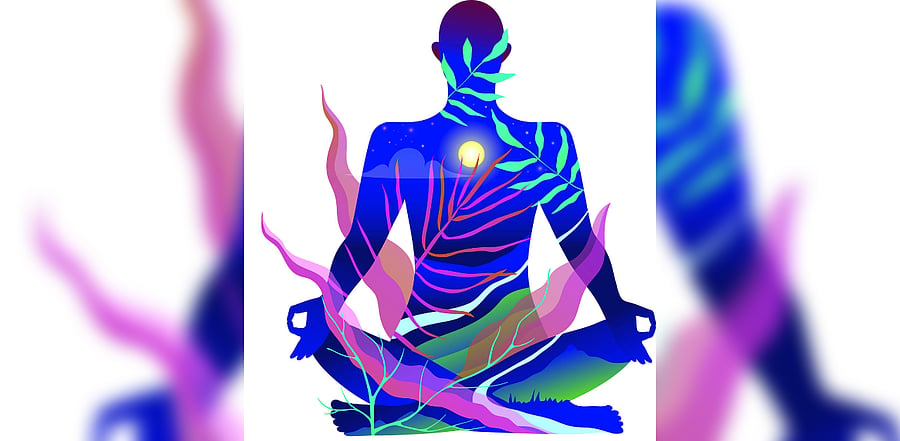The curricular content at all levels of education is heavily loaded with core subjects and skill components, to the exclusion of value education depicting the glory Indian culture and heritage. Yoga is one such glaring example.
When the entire world is admiring India for contributing yoga as a global cultural icon, it is paradoxical that our educational institutions need to be reminded about its immense potentials in moral and value education. This situation needs to be urgently corrected by affirmative action.
Yoga is one of the orthodox schools of our philosophical traditions. It is a collective of physical, mental and spiritual practices which originated in ancient India. However, it has also transcended religious barriers as its different versions were practiced by Hindu, Buddhism and Jainism.
The practice of yoga dates back to the Indus Valley Civilization (3000 BCE). A mention of yoga is made in the Rigveda and also the Upanishads. Swami Vivekananda toured Europe and the United States in the 1890s to enlighten them about the rich values of Indian culture and heritage, using yoga as an effective medium of communication.
As a tribute, a dedicated university for yoga – S-VYASA (Swami Vivekananda Yoga Anusandhana Samsthana) has been established near Bengaluru. This locational advantage of a renowned global resources institution needs to be harnessed by our education institutions to frame meaningful curricula. The potentials and latitude of yoga in value education are provided in a nutshell below.
In the Indian epic, the Bhagavad Gita, yoga is described as a meditative means to overcome suffering - Samadhi (concentration), find inner peace and salvation and to experience enlightened consciousness. In fact, each of the 18 chapters of the Bhagavad Gita is considered as a different yoga.
It is essential to understand that the true meaning of yoga lies in its cultural, religious and philosophical moorings rather than viewing it as a set of physical exercises and body postures.
Therefore, all educational institutions should incorporate the true essence of yoga with appropriate emphasis in school and higher education so that the youth are ingrained with its historical and cultural legacies, in a timeline.
Crafting a value education package comprising yoga and its benefits is urgently called for to promote holistic personality development, healthy lifestyle and at a different platitude, promote ‘Indianness’ and social leadership.
The guiding principle of the National Education Policy (NEP), 2020 is to conserve and promote the rich heritage of ancient Indian Knowledge and practices (section 0.7). Relevant courses in arts, history, culture and yoga should be strategically used by educational institutions for meaningful social engagements (section 12.7).
The pluralistic choices of Indians in integrative healthcare education system makes it imperative to give basic understanding of yoga with allopathic, ayurveda, sidhha, unani, homeopathy, community medicine and paramedical system of medical education (section 17.4).
It has been a time-tested healthy practice to embed curricula of core subjects in the overall curricular matrix of value education/non-core subjects to ensure holistic personality development of students.
This measure along with other healthy practices such as meaningful celebration of public holidays and effective mentoring would combinatorically imbibe the students with a global outlook associated with sensitivity to Indian ethos, ethics, values, heritage and culture.
The NEP 2020 provides an excellent opportunity to revisit school and higher education curricula, including professional education, to accomplish the objective.
Cultural ecosystem
Prime Minister Narendra Modi has succeeded in promoting yoga as a unique contribution of India to the global cultural ecosystem. He has also been instrumental in establishing S-VYASA, the dedicated university for yoga. In addition, integrating yoga in our lifestyle would enrich ‘Indianness’ as never before.
The United Nations General Assembly has declared June 21 as International Day of yoga. In addition, declaration of yoga as an intangible cultural heritage by Unesco has helped build yoga as an international cultural brand name.
It is noteworthy that yoga has developed into a worldwide multi-billion-dollar business, involving classes, certification of teachers, clothing, books, videos, equipment and tourism-holidays. There are ample opportunities for the Indian entrepreneurs to take yoga to new heights of international presence by crafting innovative platforms.
A desirable outcome of education should be to prime the students as ambassadors of Indian culture. This objective could be accomplished only when the government as a regulatory stakeholder mandates the educational institutions, from sixth grade to PG:
To ensure that the curricula integrate yoga with appropriate emphasis in their value education packages; involve the S-VYASA University in an advisory role
To adopt innovative ways to convey the healthcare benefits of yoga in boosting immunity of the human body, especially at the testing times of pandemic lockdown.
Create opportunities to take the benefits of yoga beyond the classrooms, to involve the stakeholders in issues relating to extension work such as school complex (cluster) management.
With concerned efforts of educational institutions, yoga could transform India into an “Incredible India”. All of India is looking at the educational institutions to make this aspiration come true.
(The writer is Adviser, Education Reforms, Government of Karnataka)
